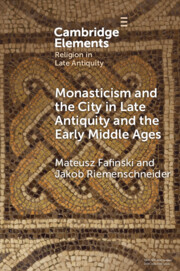Element contents
Monasticism and the City in Late Antiquity and the Early Middle Ages
Published online by Cambridge University Press: 25 April 2023
Summary
Information
- Type
- Element
- Information
- Online ISBN: 9781108989312Publisher: Cambridge University PressPrint publication: 18 May 2023
Bibliography
Primary Sources
Secondary Sources
Accessibility standard: Unknown
- 4
- Cited by
